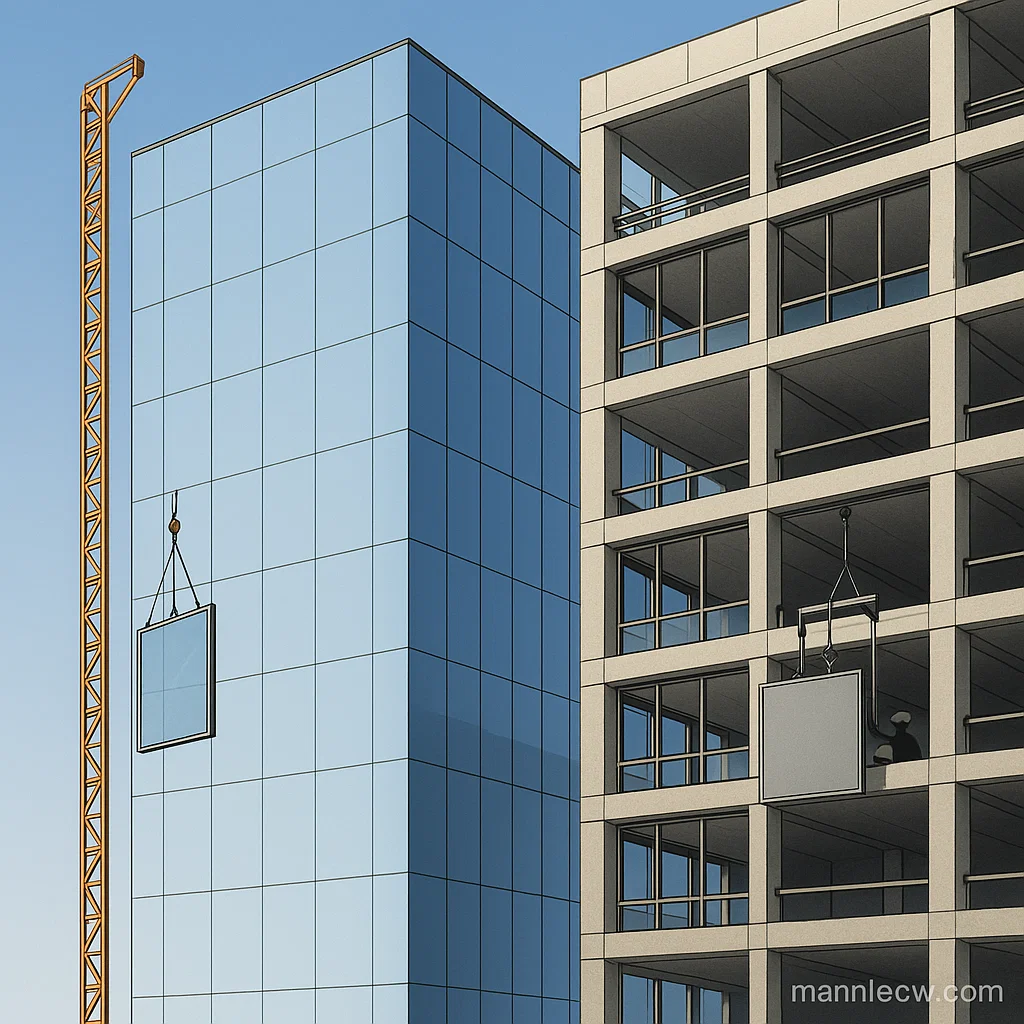Modern architecture has transformed how we perceive buildings—not just in design but also in functionality. A critical component of this evolution is the extensive use of glass systems that allow for natural lighting, aesthetic appeal, and environmental control. Among these systems, curtain walls and window wall are the two dominant choices in both commercial and residential projects.
While the terms are often used interchangeably, curtain wall vs window wall represents two distinct systems with unique structural, aesthetic, and functional implications. Choosing between them can significantly impact construction methods, energy performance, and long-term building management.
In this comprehensive guide, we explore every angle of Curtain wall vs window wall, comparing their design, installation, cost implications, advantages, and ideal use cases. We’ll also introduce mannleecw.com—a trusted provider of premium glass systems, including curtain walls, glass partitions, and more—to help guide you in making informed architectural choices.
Introduction to Architectural Glass Systems
Glass façades have become the hallmark of contemporary architecture. Whether it’s a skyscraper or a luxury condo, the right glass system doesn’t just elevate appearance—it enhances energy efficiency, indoor comfort, and property value. That’s why the Curtain wall vs window wall debate is so essential when designing buildings today.
Companies like MANNLEE have innovated extensively in this space, providing high-performance glass systems tailored to a variety of structural and aesthetic demands. You can explore these solutions at mannleecw.com.
What Is a Curtain Wall?
A curtain wall is a non-load-bearing, continuous glass façade system that is attached to the building’s structural frame. It is designed to resist air and water infiltration while managing wind loads and thermal efficiency. The curtain wall typically spans multiple floors and is anchored at floors or columns.
Key Features:
- Installed outside the building structure
- Typically used in high-rise commercial buildings
- Composed of aluminum frames with infill materials (glass, metal panels, etc.)
- Not responsible for structural load support
What Is a Window Wall?
A window wall system, on the other hand, is installed between floor slabs. It’s a unitized or stick-built glass wall system that fits within the structural openings of each floor. Unlike curtain walls, window walls are anchored at each floor and often rely on slab edges or spandrel panels.
Key Features:
- Installed within the building structure
- More common in residential and mid-rise buildings
- Typically cost-effective for smaller projects
- Provides better sound insulation due to slab separation
- Curtain Wall vs Window Wall: Key Differences
| Feature | Curtain Wall | Window Wall |
|---|---|---|
| Structural Position | Mounted outside structural frame | Installed between floor slabs |
| Load Bearing | Non-load-bearing | Also non-load-bearing |
| Installation Cost | Higher | Lower |
| Thermal Breaks | Built-in | Requires additional planning |
| Acoustic Performance | Moderate | Typically higher due to slab separation |
| Aesthetic Flexibility | High | Medium |
| Best Use Case | Commercial high-rises | Mid-rise residential or mixed-use |
Understanding this Curtain wall vs window wall matrix helps architects, builders, and developers align design with purpose.
Structural Integration
Curtain walls are hung from the structure, and their own dead weight plus environmental loads (wind, rain, thermal) are transferred to the building’s framework. Window walls, however, are anchored at each slab and act more like stacked units. This difference affects structural design, bracing requirements, and construction sequencing.
Aesthetic Considerations
From a design perspective, curtain walls offer uninterrupted glass expanses, creating seamless, sleek façades. They often use mullions and spandrel panels to mask structural elements. Window walls, because they’re installed between slabs, reveal horizontal slab edges unless covered with slab covers or spandrels.
MANNLEE provides customizable systems that address these visibility concerns, offering clean lines and versatile finishes. Explore options at mannleecw.com.
Installation and Construction Process
Curtain walls typically require field assembly, scaffolding, or cranes, making installation more time-consuming and expensive. They often involve coordination with structural steel and concrete contractors.
Window walls can be pre-glazed and unitized, leading to faster installation and lower labor costs. Since they are installed from the building’s interior, they minimize external equipment and logistics.
Energy Performance and Thermal Control
Curtain walls offer better opportunities for continuous insulation, with thermal breaks and advanced glazing configurations. They are easier to weatherproof but require meticulous detailing.
Window walls, due to slab interruptions, need more attention to thermal bridging at joints. Still, they can perform equally well when designed properly using thermal breaks and insulated spandrel panels.
MANNLEE glass systems include thermally broken frames and low-E glass options to optimize building performance—learn more at mannleecw.com.
Water and Air Infiltration
Curtain walls use drainage and pressure equalization chambers to prevent air and water infiltration. Their outer-mount design makes weather sealing more robust.
Window walls, while easier to install, require precise gasket and sealant applications between units and floor slabs. Water penetration is a higher risk if the system is not well-detailed.
Acoustic Performance
One of the strengths of window walls is sound insulation, as the concrete floor slabs between levels act as sound barriers. Curtain walls, due to their continuous structure, are more prone to noise transmission unless acoustically insulated.
This makes window walls a better fit for residential applications or mixed-use buildings with hotels or apartments.
Cost Comparison: Curtain Wall vs Window Wall
- Curtain Wall Costs: Higher due to field labor, equipment, design complexity, and support systems. Typical range: $120–$250/sq.ft.
- Window Wall Costs: Lower because of prefabrication, interior installation, and modular design. Range: $80–$150/sq.ft.
The right system depends on the building height, design intent, and budget. Consult MANNLEE experts at mannleecw.com to explore cost-effective solutions.
Maintenance and Long-Term Durability
Curtain walls, while initially more expensive, offer longer lifespan and lower maintenance, especially when high-quality components are used. They are less exposed to building movement and have fewer joints.
Window walls may need more frequent maintenance at slab joints and caulking points but allow easier unit replacement.
Ideal Applications for Curtain Walls
- Commercial skyscrapers
- Corporate office buildings
- Airport terminals
- Civic and cultural centers
- Universities and research labs
The seamless design and robust performance of curtain walls suit buildings where image, scale, and engineering precision matter.
Ideal Applications for Window Walls
- Condominium and apartment towers
- Mid-rise hotels
- Mixed-use developments
- Medical offices and retail centers
Their modular structure, cost-efficiency, and acoustic advantage make window walls a top choice for residential and urban development.
Fire Safety and Building Codes
Curtain walls often require fire-rated spandrel panels and fire-stopping insulation between floors. Since they are continuous, they pose a potential path for fire spread if not addressed.
Window walls naturally break at slabs, serving as inherent fire barriers between floors. However, penetrations for mechanical systems must still meet code.
MANNLEE ensures all systems are tested and compliant with NFPA and local fire codes.
Sustainability and LEED Points
Both systems can contribute to LEED certification through:
- Energy-efficient glazing
- Daylighting
- Recycled materials
- Improved thermal performance
Curtain walls generally have more potential due to integrated shading, triple glazing, and solar control features. MANNLEE offers green building support and documentation at mannleecw.com.
Case Studies and Examples
Curtain Wall Example:
Commercial HQ Tower, New York
- 45-story building
- Full-unitized curtain wall with integrated ventilation louvers
- Achieved LEED Gold
Window Wall Example:
Urban Condo Project, Toronto
- 25-story residential tower
- Pre-glazed window walls with slab covers
- Achieved strong sound isolation for urban living
MANNLEE systems were used in both cases, showcasing flexibility and performance.
Why Choose MANNLEE Glass Systems?
MANNLEE is a leading provider of high-performance architectural glass solutions, specializing in:
- Curtain walls
- Window walls
- Glass railings
- Glass partitions
- Custom glazing systems
Why architects, engineers, and developers choose mannleecw.com:
- Custom design support
- CAD and BIM integration
- LEED documentation
- Global project experience
- Reliable manufacturing and delivery timelines
Their systems are engineered for aesthetics, durability, and sustainability, whether for boutique residences or skyscrapers.
Future Trends in Glass Façade Systems
Looking ahead, expect innovations in:
- Dynamic glazing (electrochromic and thermochromic)
- Smart façade integration with IoT
- Greater modularity and prefabrication
- Improved insulation and solar harvesting
Both curtain wall and window wall systems are evolving to meet the needs of smart, sustainable cities, and companies like MANNLEE are leading that transformation.
Conclusion
The debate between Curtain wall vs window wall is not about which is better—it’s about what’s better for your project. Considerations like building height, aesthetic goals, acoustic requirements, and budget all play a role.
Choose a Curtain Wall if you need:
- Continuous glass design
- High-rise commercial performance
- Advanced weather and thermal protection
Choose a Window Wall if you need:
- Cost-effective installation
- Strong sound insulation
- Suitable system for residential projects




